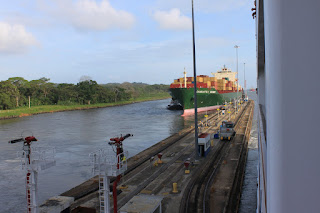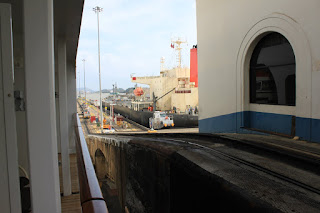Historical/Background Info:
Exciting day as we are transiting the Panama Canal. This is our 8th time to go through the canal but I will never get bored with it. People as us all the time what our favorite cruise has been. This right up there at top of the list!!! The history and engineering of the canal is remarkable to say the least. Construction of the canal began in 1904 and was not completed until 1914 at a cost of $352 million dollars. Hard to say what it would cost today. Because of landslides it was closed and the formal opening was delayed by WWI until 1920. The French started to build the canal back in 1880, but after 22,000 laborers died from yellow fever and malaria due to the mosquito’s, they gave up. The United States stepped in to build it in 1904. The US controlled and provided the defense for the Panama Canal Zone until 1977 when a gradual hand over to the Panama Canal Authority was completed in 1999. So now the Panamanian government owns and operates the canal. (Big mistake in my humble opinion but Jimmy Carter was President then) The canal currently has a workforce of 9,000 employees and operates 24 hours a day, 365 days a year. I bet most of you thought the Panama Canal runs East-West. WRONG! The canal actually runs North-South.
We began our transit of the canal at 7:00 this morning. The first set of locks are the Gatun locks at Limon Bay (Caribbean Sea/Atlantic side of Panama). The Gatun locks consist of three chambers. The ship is raised in each lock by water from the chamber above it. Gravity moves the water to equalize the water levels and the ship rises. The Gatun locks raise our ship 85 feet above sea level and into Gatun Lake. This huge lake was formed mostly by damming up the rivers. The engineers had to make an 8 mile cut through one section which is called, The Gaillard Cut. Thirty million cubic yards of rock and dirt had to be excavated by steam shovels. We are sailing 23 miles across Gatun Lake to reach our next lock, called the San Pedro Lock. Here we will start our descent to sea level on the Pacific side. The San Pedro chamber will lower us 31 feet and then we will enter Miraflores Lake. From the San Pedro lock to the final set of locks, the Miraflores Locks, it is only little over a mile. So basically right back into the Miraflores Locks which consist of 2 chambers that will lower us a total of 54 more feet down to sea level again. So we went up 85 feet and then down 85 feet. The total Panama Canal transit is 51 miles and takes between 8 to 10 hours depending on traffic. Each lock chamber is 110 feet wide and 1050 feet in length which can handle the Panamax size cargo ships. There are two lanes in each lock so two ships can go through at the same time thus saving water from the lake. When the gates of the locks open at sea level, 26 million gallons of water from Lake Gatun goes into the ocean and is lost. This happens on both sides so 52 million gallons of water is used for each transit. What makes the canal work is all the rain that Panama gets to keep the lake full all the time. A new lane through the canal is now under construction with larger lock chambers so it will be able to handle the newer and larger cargo ships as well as United State’s aircraft carriers. They now have to go all the way around South America to get from Atlantic to Pacific oceans. The estimated cost of the new lane is $5.25 billion and the locks are designed to use 7% less water lost. The new lane was due to open in 2014 in time to celebrate the 100th anniversary of the canal but is now delayed until April 2016.
By the way, the cost for our ship’s transit today is about $150,000. Fares size and type of cargo ship but cruise ships pay based on number of passengers. Each ship’s company has to wire the money to Panama PRIOR to its transit. No credit cards, thank you!!
There is a viewing stand at the Miraflores Locks for visitors to come see the ships intransit. It’s always fun to wave at them as we pass by. The visitor’s center is only 20 minute taxi ride from Panama City, Panama. About 30 minutes after exiting the last lock chamber we pass under the Pan American Highway Bridge on north edge of Panama City. This series of highways is 30,000 miles long and except for a 60 mile gap you could drive from northern Alaska to southern South America.
What We Did Last Night:
Susanne being served some spaghetti by Dennis.
The pieces of veal parm were huge. I will have them put more marinara sauce over it before the cheese next time however. Don't get me wrong, we really enjoyed it. The fried calamari was also delicious.
The folkloric show was indeed very colorful and interesting.
The narrator said this dress costs $25,000.
Photo is of the whole cast after the show.
What We Did Today:
Two tugs on each side of our ship to get us lined up perfectly for entering the first lock.
I think this will be on tonight's menu.
A large alligator watching us as we were about to enter the lock. It probably wanted me on his menu.
Now entering the first of the three Gatun locks. The 3 locks will raise us 85 feet to the level of Gatun Lake.
A container ship entering the lane next to us. There are two lanes in use 24 hours a day, 365 days a year. The new larger lane will be opening in a few months, April I believe.
The lock gates each weigh 662 tons mounted on 17 ton hinges. They are perfectly balanced as it only takes two 25 horse power hydraulic motors to open and close them. The gates are overhauled every couple of years.
We are being raised inside the lock as water from the lock above is allowed to enter our lock by gravity through 18 foot diameter tunnels in the center portion of the canal locks. You can see the water entering lock now raising our ship like a cork.
The 3 Gatun locks on the Atlantic Ocean side of the canal will raise our ship 85 feet up to the Gatun Lake.
Miraflores Locks-Consists of two locks that finish lowering us to sea level.
Gates being closed behind us. Notice the water level on gates.
Gates now closed and we are about to be lowered.
Note water level now on gate after being lowered.
Ship coming into the lock behind us. I took this from top deck of our ship after we were lowered.



































































No comments:
Post a Comment